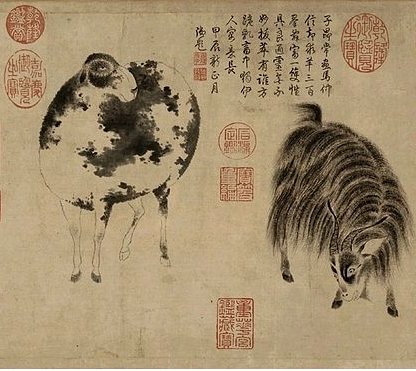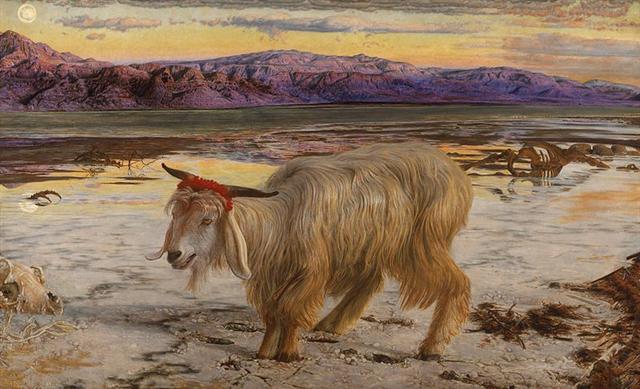One could think a 2nd hakaariki (making a king) glyph
could arrive after Capella in Cb2-24. However, this was
evidently not the case:
|
MAY 18 |
19
(*59) |
20
(140) |
 |
 |
 |
|
Ca4-1 (77) |
Ca4-2 |
Ca4-3 |
| kua
tupu te rakau |
kua
tupu - te kihikihi |
te hau
tea |
|
June 7 |
8 |
9 (160 = 140
+ 20) |
| |
MINTAKA
(*82) *285 |
ALNILAM,
ARNEB, HEKA
RAS ALHAGUE |
|
MAY 21 |
22 |
23 |
24
(*64) |
25 |
26
(146) |
 |
 |
 |
 |
 |
 |
|
Ca4-4 |
Ca4-5 |
Ca4-6 |
Ca4-7 (83) |
Ca4-8 |
Ca4-9 |
| tagata
- te rau hei |
te
hokohuki i te moko |
te rau hei |
e gagata hakaariki |
manu
|
te rau hei |
|
June 10 |
11 |
12 |
13 |
14 (165) |
15 |
|
ALNITAK,
PHAKT, HEAVENLY GATE |
|
|
WEZN (*87) |
BETELGEUZE
ZUBEN
ELGENUBI |
PRAJA-PĀTI,
MENKALINAN, MAHASHIM |
Instead we will find a fluid kava glyph
5 days after Capella:
|
APRIL 6
(461) |
7 (*17) |
|
MAY
17 (137) |
18
(*58) |
 |
 |
|
Cb3-1 (50) |
Cb3-2 (443) |
| E vae
ra - ka oho - ki te henua - kua huki |
ku
kikiu - te henua |
|
June
6 (157) |
7 (*81 - 3 +
80) |
|
ELNATH (*80) |
*81
*264 |
|
December 6 (340) |
7 (*264 - 3
+ 80) |
|
NOVEMBER 16 (320) |
17
(*241) |
... Huki á te mahina, said of the new moon
when both its horns have become visible ...

 |
 |
|
kava |
Cb3-4 |
|
APRIL 15
(*390) |
16 (106) |
17 (*392 =
107 + 365 - 80) |
|
MAY 26
(146) |
27
(*432) |
28
(*68 = *91 - 23) |
 |
 |
 |
|
Cb3-10 (59) |
Cb3-11
(452 = 392 + 60) |
Cb3-12 |
|
te
taketake |
henua |
kiore -
henua |
|
June 15 (166
= *89 + 77) |
16 |
17 (148 +
20) |
|
PRAJA-PĀTI,
MENKALINAN, MAHASHIM |
NASH (*273) |
*91 |
|
December 15 |
16 (350 =
290 + 60) |
17 (331 +
20) |
|
OCTOBER
15 |
16 |
17 (290 =
107 + 183) |
|
NOVEMBER 25 (329) |
26
(*250 = *273 - 23) |
27 |
The figure in Cb3-10 (59) is formed similar to the 2nd
of our earlier heke glyphs:
|
FEBRUARY 15
(46) |
346 |
JANUARY 28
(393) |
61 |
MARCH 31 (28
+ 62) |
APRIL 1 (91) |
13 |
APRIL 15
(105) |
|
MARCH
28 (87) |
MARCH 11 (69) |
MAY 11 (90 + 41) |
12
(132) |
MAY 26
(146) |
 |
 |
 |
 |
 |
|
Ca2-1 (27 =
87 - 60) |
*Ca14-11 (374) |
Cb2-20 (436) |
Cb2-21 |
Cb3-10 (451) |
|
Te heke |
te heke |
ka tuu te toga o
te manu |
kua tapu - no te
manukua tapu - no te manu |
te
taketake |
|
April
17 (*27 + 80) |
March 30
(89) |
May 31 (151) |
June 1 (152) |
15 (166) |
|
HAMAL (*30)
MENKENT (*213) |
*377 = *12 +
365 COR
CAROLI (*195) |
HAEDUS I
(*74)
*257 |
HAEDUS II
(*75) |
PRAJA-PĀTI,
MENKALINAN, MAHASHIM
*272 |
|
October 17
(290) |
September 29 (272) |
November 30 (334) |
December 1
(75 + 260) |
December 15
(349) |
|
AUGUST 27
(229) |
JULY 30
(211) |
SEPTEMBER 30
(273) |
OCTOBER 1
(274) |
OCTOBER 15
(288) |
|
SEPT
27 (270) |
SEPT
9 (252) |
NOV 10
(314, π) |
NOV 11 (315) |
NOV 25 (329) |
I think 'the long established' (te taketake)
at Cb3-10 was placed at the vertical
'line of fire' at the end of the main part of Auriga:

|
Take
The Marquesans are the only people who
own to a distinctive national name, and retain a
tradition of the road they travelled from their original
habitat, until they arrived at the Marquesan Islands.
They call themselves te Take, 'the Take
nation'. Fornander.
Take, Tuvaluan
for the Black Noddy (Anous Minutes). The
specific epithet taketake is Māori for long
established, ancient, or original. In the Rapa
Nui mythology, the deity Make-make was
the chief god of the birdman cult, the other three
gods associated with it being Hawa-tuu-take-take
(the Chief of the eggs) his wife Vie Hoa and
Vie Kanatea. Wikipedia.
|
However, precession had moved its ancient
position ahead in the year with a pair of months, from APRIL 15
(105) to 166 (June15) - equal to the
distance from December 30 (364) to March 1 (60). Therefore Mother Goat (Capella) and her twin
offspring had to be pictured at the back side of the Charioteer.
They were no longer at the place were the winter
year was ending.
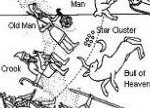
Instead the summer year was now defined by sheep (an
animal which was domesticated later than the goat):

...
Many think that our
figure [Aries] was designed to represent the Egyptian King of
Gods shown at Thebes with ram's horns, or veiled, and crowned
with feathers, and variously known as Amon, Ammon, Hammon, Amen,
or Amun, and worshiped with great ceremony at his temple in the
oasis Ammonium ...
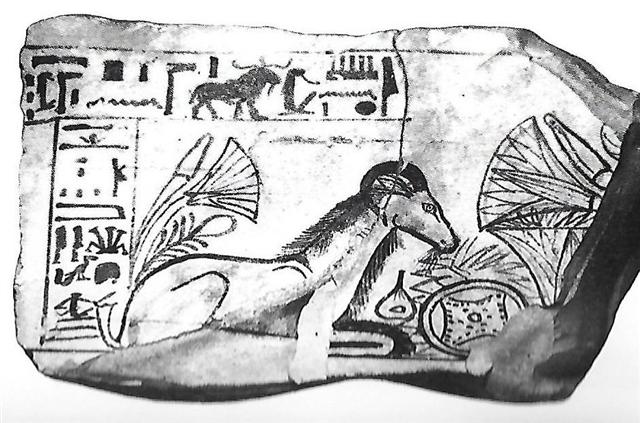
... However,
Wilkinson explains there were two kinds of wether in ancient
Egypt. One of them (above) was Ovis platyra, with curved
horns and usually depicted as reclining:

Ovis platyra
was Allen's Amon wether. It was the modern type of sheep.
However, early there was another species, Ovis longipes,
the first kind of sheep domesticated in Egypt. It had a more
powerful body with a thick fur and wavy horizontally oriented
horns:
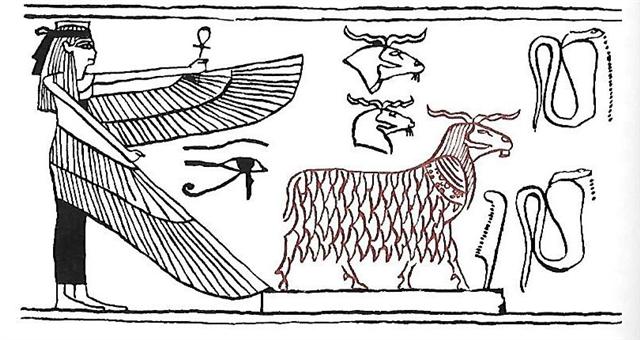
Not surprisingly
this kind of sheep was associated with the 'nighttime' voyage
through the Underworld:
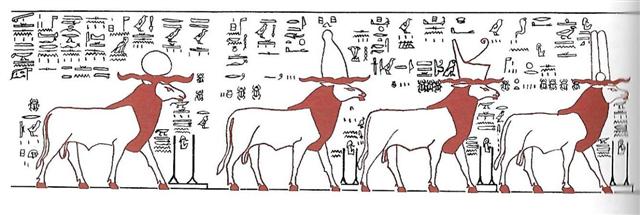
Wilkinson begins
his description of the Egyptian Ram pictures by pointing out
that these sheep were lead by a wether when they were used for
pushing down seeds into the mud after the yearly inundation of
the Nile ...
I have no idea of what the Chinese text below is
saying, but I can guess its main ingredient:
